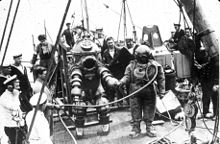Stinger suit

Two divers, one wearing a 1 atmosphere diving suit and the other standard diving dress, preparing to explore the wreck of the RMS Lusitania, 1935
|
|
| Uses | Protection of the diver from the environment |
|---|---|
A diving suit is a garment or device designed to protect a diver from the underwater environment. A diving suit may also incorporate a breathing gas supply (i.e. Standard diving dress or atmospheric diving suit). but in most cases applies only to the environmental protective covering worn by the diver. The breathing gas supply is usually referred to separately. There is no generic term for the combination of suit and breathing apparatus alone. It is generally referred to as diving equipment or dive gear along with any other equipment necessary for the dive.
Diving suits can be divided into two classes: "soft" or ambient pressure diving suits - examples are wetsuits, dry suits, semi-dry suits and dive skins, and "hard" or atmospheric pressure diving suits - armored suits that keep the diver at atmospheric pressure at any depth within the operating range of the suit.
The first diving suit designs appeared in the early 18th century. Two English inventors developed the first pressure-proof diving suits in the 1710s. John Lethbridge built a completely enclosed suit to aid in salvage work. It consisted of a pressure-proof air-filled barrel with a glass viewing hole and two watertight enclosed sleeves. This suit gave the diver more maneouverability to accomplish useful underwater salvage work.
After testing this machine in his garden pond (specially built for the purpose) Lethbridge dived on a number of wrecks: four English men-of-war, one East Indiaman (both English and Dutch), two Spanish galleons and a number of galleys. He became very wealthy as a result of his salvages. One of his better-known recoveries was on the Dutch Slot ter Hooge, which had sunk off Madeira with over three tons of silver on board.
At the same time, Andrew Becker created a leather-covered diving suit with a helmet featuring a window. Becker used a system of tubes for inhaling and exhaling, and demonstrated his suit in the River Thames, London, during which he remained submerged for an hour.
...
Wikipedia
